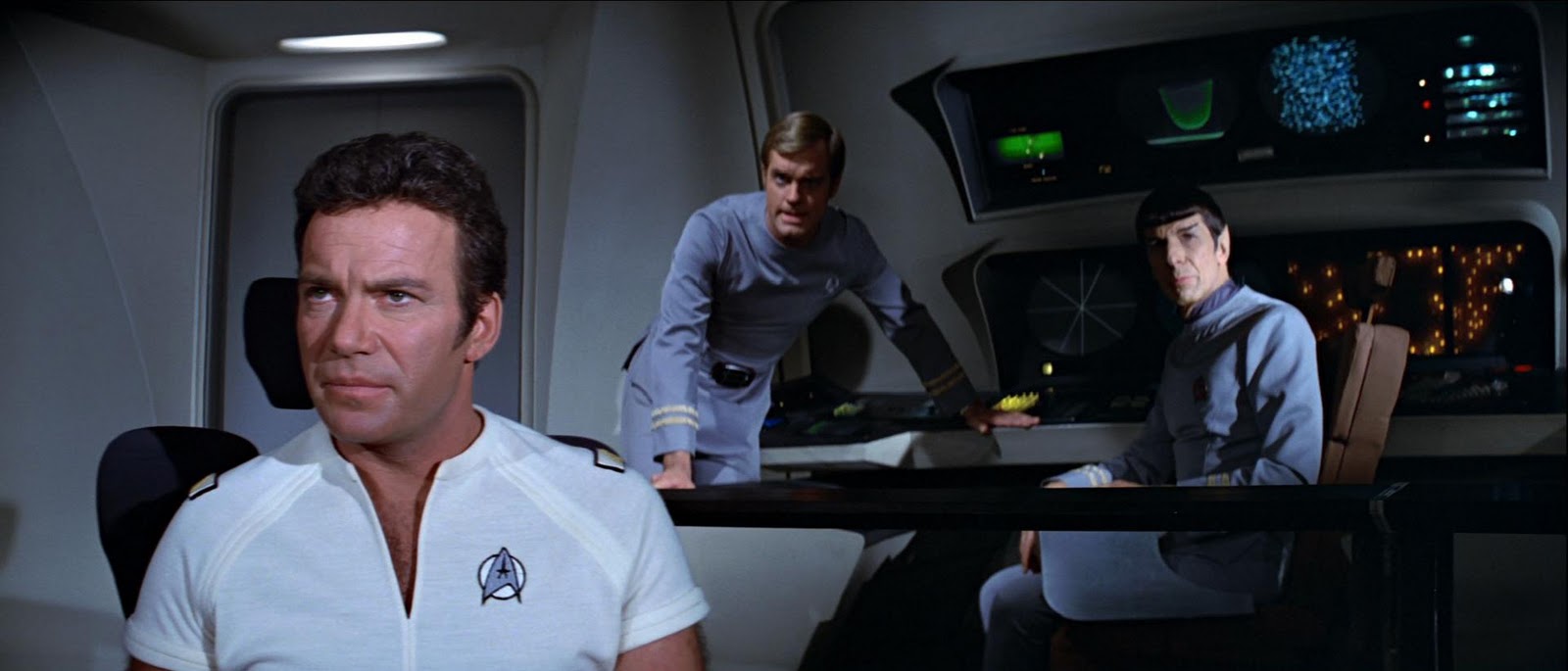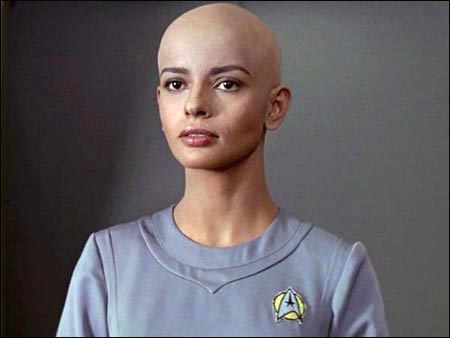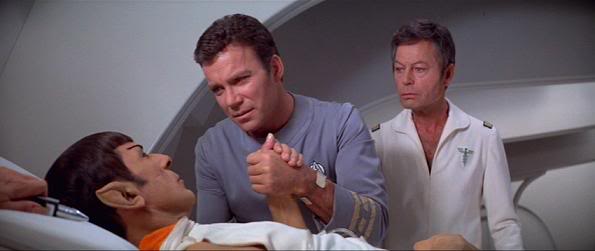
More than two years and tons of Klingon forehead reconstruction surgery since the end of the Enterprise’s historic 5-year mission, Admiral Kirk takes command of the refitted Enterprise to prevent a dangerous energy cloud from reaching Earth. He displaces Captain Willard Decker (Stephen Collins) who stays on the ship as executive officer. Kirk brings Bones out of retirement and picks up Spock along the way (they were getting the band back together, it seems). Turns out Spock sensed an intelligence from the cloud while he was on Vulcan trying to be more Vulcan, and wants to join the Enterprise to learn more about it. The cloud thing sends a probe to the Enterprise that kills and then reappears as sexy navigator Ilia (Persis Khambatta, who spends the rest of the movie wearing nothing but heels and a doctor’s lab coat). Ilia Probe tells Kirk that something called V’Ger is searching for its creator. Eventually, the crew finds the object at the heart of the cloud: actually Voyager 6, an ancient Earth probe that has gained sentience with the help of a mechanical civilization in another part of the galaxy. When the only way to arrange the meeting is to have V’Ger merge with a human, Decker volunteers. Decker had long been in love with Ilia, a Deltan, who took a vow of celibacy. He merges with what’s left of Ilia, and with her V’Ger, and the cloud vanishes — just as it’s poised to attack Earth. With civilization saved as they know it, Kirk, Spock and McCoy return to the bridge of the Enterprise, to (presumably) set out on new adventures.

Why it’s important
In the Star Trek universe, the significance of the events of “The Motion Picture” is pretty obvious. Earth, one of the founding worlds of the Federation and headquarters to Starfleet Command and Starfleet Academy, was very nearly left without any human life. The actions of Kirk and Co. saved the planet, while putting the pieces in motion for more adventures of the crew on the Enterprise. More on that in a bit.
In the real world, the success of “The Motion Picture” brought Star Trek back from the dead (with all apologies to The Animated Series). Anyone reading this review knows what this film begat as far as movies, spinoffs, etc. So, while it’s not a perfect movie — and while it’s an oddity in the franchise in a lot of ways, as we’ll discuss — it was a very big deal.

What doesn’t hold up
Most of “The Motion Picture” works OK as far as what we know of Trek history. It’s odd that the creators chose to put the events of the movie just 2 1/2 years after the end of the 5-year mission, when 10 years had passed in real life. The actors sure look a heckuva lot older, DeForest Kelley being the most egregious example. There’s also the matter of whether Kirk had another 5-year mission in the 13 years in the Star Trek timeline after this film and before “Star Trek II: The Wrath of Khan”. It certainly seems like that’s what happened, based on dialog, but it’s never really stated. We do know that at some point between the two films, Kirk left Starfleet (“Star Trek: Generations”) but there are still a lot of years unaccounted for.
And, of course, the Klingons certainly look different than they did the last time we saw them way back in “Day of the Dove”. Actually, the Klingons here look different than they do going forward, as well.
But the biggest oddity about “The Motion Picture” to me has always been that it’s much more akin to “2001: A Space Odyssey” and to a lesser extent “Star Wars” than The Original Series, or anything in the franchise after it, for that matter. Part of that is the ’70s-tastic look of the Enterprise and uniforms, most of which is gone by the next movie in 1982. Part of it has to do with showcasing effects that weren’t possible for television in the 1960s. And there’s the (much) slower pace.
Little if anything else in Star Trek attempts the a more sweeping story or such a hard sci-fi edge. Maybe that’s why the events of this film, as significant as they are, never get mentioned again in Star Trek. The closest thing I can think of is the offhand remark by the Federation president on Earth in “Star Trek VI: The Undiscovered County” that Kirk and McCoy had “literally saved this planet.” Of course, he could have been referring to other events, such as those in “Star Trek IV: The Voyage Home”.
Final thoughts
“The Motion Picture” isn’t the worst of the Star Trek films, and it’s arguably better than the last two TNG films, to say nothing of the absolutely awful “Star Trek V: The Final Frontier”, elements of which were considered apocryphal by Gene Roddenberry. The scene in “The Motion Picture” where we first see the Enterprise is pretty wonderful and most of the acting is OK, though there are odd/forced moments from just about every member of the cast. Walter Koenig, in particular, wasn’t on his A-game in this movie.
But it’s also, arguably, the hardest film to sit through because of the unnecessary scenes with crew members staring agape at the view screen as the ship travels through the energy cloud. Plus, the ending is extremely rushed and suffers from the Extemporaneous Dialog Diagnosing a Complex Problem trope so common in TOS. How Kirk, Spock, McCoy and Decker put together everything that’s going on and come up with a solution — despite a lack of much evidence and an only somewhat helpful Ilia Probe — is a real stretch. Unfortunately, the creators harked back to The Original Series in one of the most annoying ways.
“The Motion Picture” almost feels like an estranged, but not altogether dismissed or decried, relative of the franchise as a whole (it’s the quasi-estranged uncle, whereas “Star Trek: V” is the red-headed stepchild). Four of the next five movies really are part of a continuing saga. But “The Motion Picture” — even more so than “The Final Frontier” — stands alone.
The early parts of “The Wrath of Khan” — where Kirk is feeling past his prime and out of place riding a desk on Earth — could fit right after the events of TOS. Why there’s no acknowledgement that Kirk essentially went through the same soul-searching in both movies is really weird. Why Bones didn’t say something like, “Jim, you went through this before the incident with V’Ger when you got the Enterprise back,” or something to that effect is odd. Kirk is in his late 30s in the first movie and turns 50 in the second, so perhaps the idea of him getting old in the second movie needed to be buoyed — and it certainly works as a thematic device in both films. Or, maybe, the creators didn’t figure they’d make audiences remember what happened in a movie from three years earlier?
Last point: This movie might be the first instance in which the creators pushed back the Trek timeline. As noted in other reviews, dialog in several TOS episodes indicates that TOS occurred about 200 years in the future (which would have put it in the late 22nd century). But Decker, near the end of the movie, notes that Voyager 6 left Earth about 300 years ago, in the late 20th century. The lack of fast-track space exploration in the decade between TOS and this movie probably made the creators push everything back. From now on, it’s pretty clear that TOS took place 300 years after it originally aired.
Coming next week …
Well, we certainly wouldn’t be reviewing any film revolving around a character whose name rhymes with Schman Schmoonien Schmingh. Nope, no chance of that …
